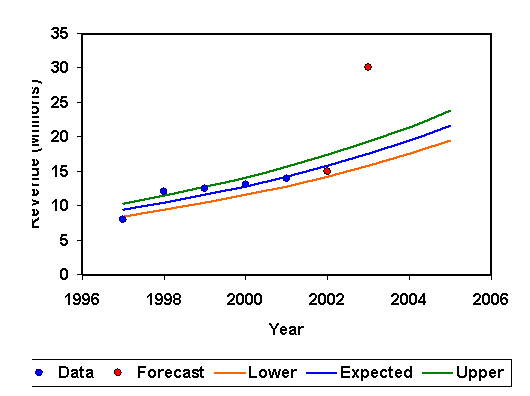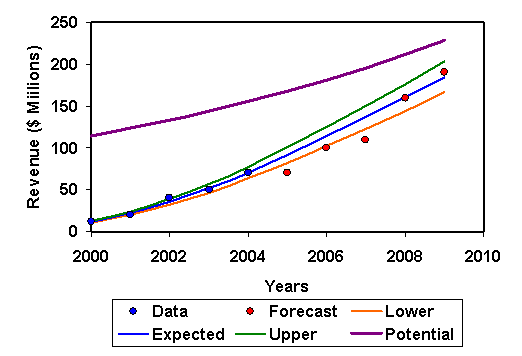P.O.
TEL: (831) 854=2256
genelieb@lieb.com
Auditing Forecasts
Forecasts and strategic plans have become critical tools for business evaluation, financial control and operations. While it is not possible to assure that forecast will foretell the future, they can be audited to assure consistency, reasonability and freedom from undue bias. Custom Decision Support, LLC. has been developing business analysis tools. These tools are appropriate for this auditing activity.
The goals of the forecast auditing are assure that the forecasts are reasonable, consistent, and have been developed using generally accepted principles. It is the function of the audit to determine that the forecasts are in fact reasonable expectations of the future performance of the business following a tractable plan and based on anticipated business and economic structures. Unfortunately, the audit can not determine if the forecast is valid, only that it is reasonable based on what is known.
Is the Forecast Consistent?
Most markets are orderly. The orderliness of the business environment is observed in consistent behavior patterns in sales, costs, prices, and sales volumes. Over many years specific standard trends have been identified including sales growth characteristics, price/volume curves, price-point distributions, and learning curves. While deviations from these trends have been noted, there are generally the exceptions not the rules. These curves are used by Custom Decision Support, LLC to check consistency of forecasts.
Are the Forecasting
Procedures Reasonable?
Forecasts must have input from all functions of the business, including production, marketing, as well as planning and management. While total agreement of all business functions on a forecast is unlikely, the forecast should represent a reasonable consensus of the business organization.
The best practical methods should be used in preparing forecasts, with care taken to eliminate undue bias, either positive or negative. A key function of the audit is to determine the identity and extent of that bias.
Is the Forecast Valid?
Where data is available, the forecast audit attempt to assess the validity of the forecasting procedure by testing historical performance. Statistical analysis of past forecasts against actual performance can real inherent bias and overall accuracy.
The Auditing Process
It is not possible to assure that sales or earnings forecasts will be achieved. However, forecast audits can determine if the forecast is reasonable, achievable, and is based on the best available information. Forecasts usually reflect both the realities of the business and the hope to grasp future opportunities. As long as the reach of the forecast does not exceed the grasp of reality, such forecasts are not unrealistic. However, often they are, and the best hopes produce unrealistic forecasts. The CDS forecast audit process is designed to verify:
- Historical consistency;
- Resource sufficiency;
- Reasonability; and
- Market validity.
The objective of the audit is not only a critical review but also assistance in both making reasonable forecasts and providing the means by which ambitious forecasts can be realized. The following is a general outline of forecast auditing elements:
1. Objectives, Purpose, and Goals
2. Inclusive Development including: Sales Involvement, Goals and Quotas, and Production Commitment
3. Historical Feasibility including: Historical Trends, Confidence Limits, Price Trends, and Costs
4. Market Compliance
5. Risk Assessment including: Product Position, Competitor Behavior, Economic Trends, and External Events
6. Requirements including: Programs/Initiatives, Marketing Programs, and Sales Resources
7. Resources including: Budgeting, Distribution of Resources, and Management Commitment
Auditability
Financial and sales forecasts are undertaken for a number of reasons; serve a number of purposes and are constructed using a number of methods and approaches. The uncertainty in the forecasts and their inherent errors reflect these differences. Not all forecasts are intended for investment or financial planning purposes. Only those forecasts intended to represent future earnings and based on expected performance within constrained resources can be considered for auditing.
Historical Analysis
Historical analysis provides a basis of determining the reasonability of forecasts. If nothing changes in resources and programs, the historical trend is the best that can be expected.

Rapid growth has long been a problem of forecasting. CDS has pioneered the development of predictive sales growth models capable of bounding the physical sales of products. These models have been incorporated into CDS's Forecast Audit procedures.

Forecast Audits can be arranged as an independent project or as a part of a broader planning program.